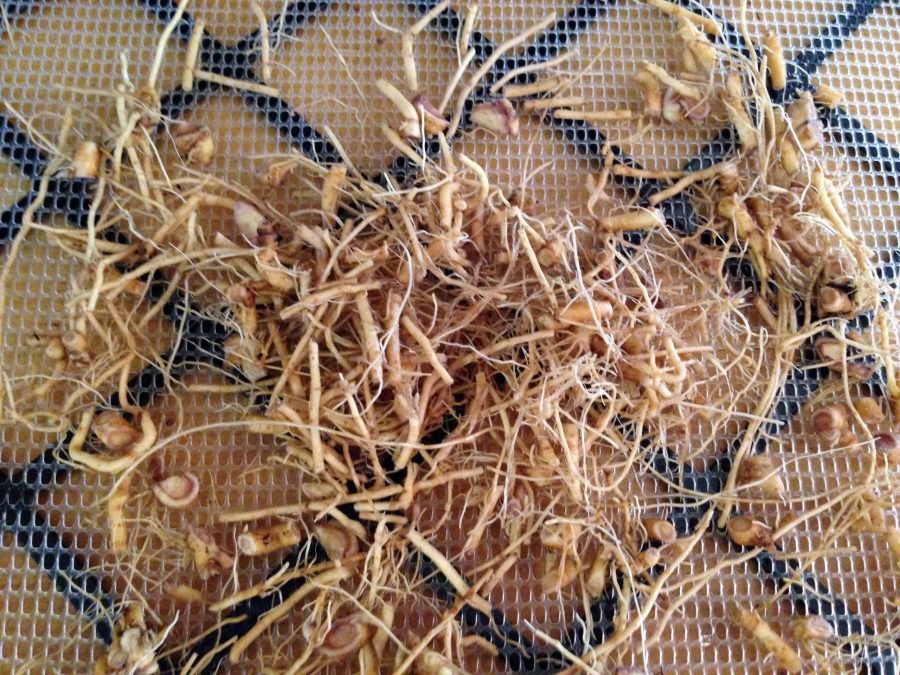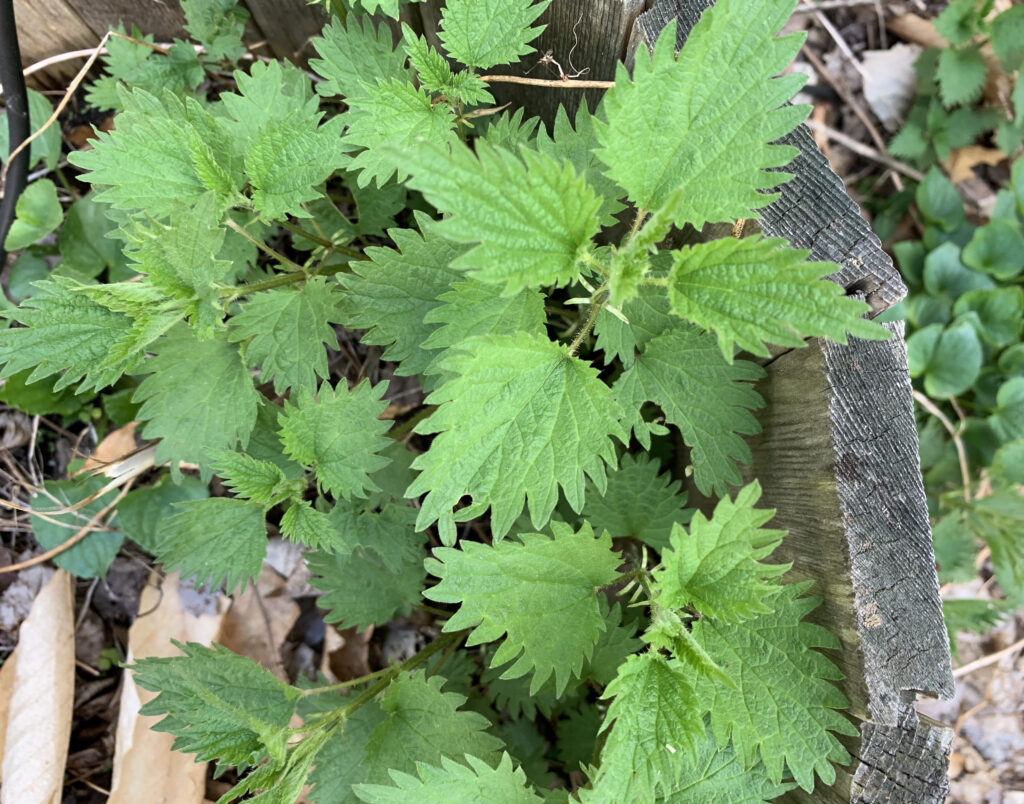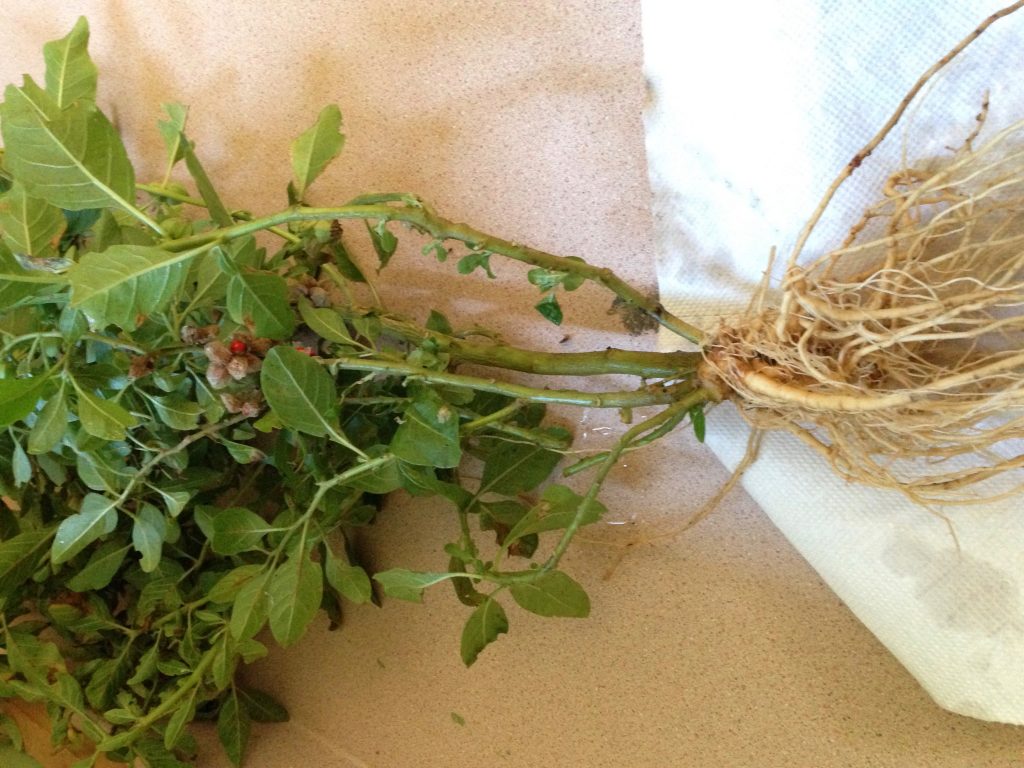Survey your peri- and post-menopausal friends and relatives, and you might discover a surprising trend: almost all of them have a thyroid issue and/or are on levothyroxine (brand name Synthroid). Well, not all of them, but probably an awful lot. They may have been put on medications based solely on lab results after routine screening, or they may have gone to the doctor feeling utterly exhausted, gaining weight in spite of healthy diet and exercise, losing hair, thinning eyebrows, a bulging or creased throat, or feeling unusually cold all the time.
According to some statistics, one in five women over the age of 60 has clinical or subclinical hypothyroidism, possibly more, and thyroid disorders are five to eight times more common in women than men. Although any gender, at any age, can develop hyper or hypothyroidism, autoimmune thyroid disorders are more likely to develop during times of major estrogen fluctuations – not only peri/post-menopause but also in pre-/post-natal folks.
There are a few different types of thyroid conditions, with various causes that may or may not be autoimmune in nature, 85 percent of thyroid conditions in the United States are hypothyroid, and of hypothyroid cases, 95% are autoimmune Hashimoto’s thyroiditis. In this article, I’m going to focus specifically on support for Hashimoto’s hypothyroidism.
A recent thyroid diagnosis often begs the question, “Is there anything I can do to naturally support my thyroid?” The answer is a resounding, “Yes!” As far as whether or not you will still need to take a drug like levothyroxine, the answer will vary widely, require doctor supervision, and likely benefit from the additional support of an herbalist or naturopathic doctor. Natural approaches tend to have the most benefit in early and subclinical thyroid states. Some herbs can be also be used alongside medication while others should only be combined with professional supervision and caution due to the risk of overstimulating the thyroid and causing potentially dangerous and lethal hyperthyroid storm.
Understanding Thyroid Hormones & Reading Thyroid Labs
Your thyroid is a butterfly shaped endocrine gland in your throat near where an Adam’s apple would be that produces thyroid hormones, particularly T4. Via a complex chain of events, thyroid hormones help govern the pace at which everything takes place throughout the body: body temperature, metabolism and calorie burn, energy levels, digestive prowess, and much more. It’s like the engine of a car or the little motor in one of those wind-up toys that hop across the floor. When it’s running smoothly, the body functions well. If it gets sluggish, various body processes sloooooow down (hypothyroidism). If it’s over-stimulated, things speed and burn up (hyperthyroidism).
The most popular, reliable, and affordable lab test to assess thyroid function is TSH (thyroid stimulating hormone). TSH is released by the pituitary gland in the brain and signals your thyroid – like a foot on the gas pedal – to produce T4 (comprised of four iodine atoms with tyrosine), which is the most abundant thyroid hormone in the body. As needed, throughout the body, T4 is converted into T3 via a selenium-based enzyme that removes one of the iodine atoms. (Get it? The number refers to the quantity of iodine atoms.) T3 – particularly in its “free” (versus “bound”) state – is the most potent and active thyroid hormone in the body. As T3 levels reach adequate levels, TSH takes its foot off the gas petal a tad. If T3 (and typically also T4) begin to dip, TSH presses harder on the gas pedal.
Sometimes as thyroid function falters, T3 and T4 might look normal on lab tests because TSH is able to compensate but raising higher – pushing harder on the gas pedal to push a sputtering engine into action. So, having a high TSH usually indicates that the thyroid is under-functioning (hypoactive) while having a low TSH usually indicates the thyroid is over-functioning (hyperactive).
What’s “normal”? Adding to the confusion of the alphabet soup of thyroid labs, different practitioners and labs have dramatically different “normal” ranges for TSH. Labs run by hospitals and general practitioners may consider 0.3 to 6 uIU/mL “normal”; however, most endocrinologists would prefer to see TSH under 3, noting that as the TSH starts to approach and surpass 2.3 uIU/mL, subclinical hypothyroidism is likely creeping in, and the earlier it’s treated, the better a client will fee. Functional medicine and naturopathic doctors prefer to see clients within an optimal range of 0.6 (or 1) to 2 uIU/mL. If you’re suspicious about your thyroid function, ask for a copy of your TSH level and consider asking your doctor to test your antibodies as well. (Insurance may not cover antibody tests, especially if your TSH is normal, and it tends to be a more expensive test. You can order your own lab tests, paid out of pocket but often discounted, via companies like Ulta Labs and Life Extension, too.)
Why is the thyroid faltering? There are a variety of reasons (including iodine deficiency), but in the vast majority of United States cases, it’s autoimmune disease. A haywire immune system decides that compounds relating to the thyroid or thyroid hormones are the enemy and forms antibodies that attack it. TPO antibodies can be tested and are a potential measure of the level of attack on the thyroid that underlies hypothyroid disease. TGAB antibodies are a more downstream effect relating to the level of damage the thyroid has endured. (TSI antibodies relate more to Graves’ autoimmune hyperthyroidism.) Holistic practitioners often test TPO antibodies to assess how well they’re addressing the root cause of the condition. Conventional doctors rarely test antibodies because conventional medicine – unlike natural care – has very few safe options for addressing autoimmune disease. It’s easier and effective to supplement T4 with medications to maintain homeostasis and ignore the autoimmune component.
But why is the body attacking itself in the first place? We have a lot of theories but few solid answers, and it might be a complicated and individualized combination of them. Possible triggers or aggravators include nutrient deficiencies, aging, estrogen wobbles, stress, trauma, sleep deprivation, environmental pollutant exposure (including mercury, radiation, and plastics like BPA), intestinal permeability (leaky gut), food allergies and sensitivities (gluten and soy chief among them), and microbiome balance. Some theorize that environmental exposure to halogens like fluorine, bromine, and chlorine disrupts iodine and T3’s ability to enter cells to do its job as well.
You may have heard that goitrogenic foods like broccoli can inhibit thyroid function, but this is not likely to occur, especially if it’s usually cooked and/or you have adequate iodine levels. Cases of goitrogenic foods triggering hypothyroidism usually involve populations that were both severely malnourished and eating an unusually large percent goitrogenic foods due to limited food availability. You can safely eat cruciferous veggies – which are extremely healthy and help fight breast cancer and balance reproductive hormones, among other benefits – just cook them most of the time.
A Thyroid-Friendly Diet and Lifestyle
Try to sleuth out and address your own personal potential underlying triggers of autoimmune disease. These approaches are slow but often helpful in a wide range of autoimmune thyroid condition (hypo and hyper) and safe alongside medications.
Consider eliminating all gluten and soy for six months to see if you feel better without them, then reintroduce to see how you feel. Both have the potential to disrupt thyroid function and/or trigger autoimmune disease. Not everyone reacts poorly to these foods, but if you find them problematic, you may want to avoid them entirely going forward. (Fortified wheat products are a common source of B vitamins in the diet, so be sure to get your B complex elsewhere – via animal protein and dark leafy greens and/or a basic multivitamin.)
Take care of your mind-body balance via stress management, trauma support, and quality sleep. If needed, seek the support of herbs including adaptogens, nervines, and sedatives based on your needs as well as professional support including therapy, and lifestyle approaches like yoga, meditation, journaling, time in nature, and regular exercise.
Nourish your body to ensure your minerals and other nutrient levels are adequate, which supports thyroid and immune function. Selenium (particularly in the form of selenomethionine) supports healthy thyroid and immune function and may favorably shift Hashimoto’s and other thyroid conditions. Get your ferritin (iron) levels tested to ensure they’re adequate. Consider supplementing with vitamin D, calcium, and magnesium and/or eating foods and herbs rich in these nutrients. Herbalists Rosalee de la Foret and Sajah Popham both find strong nettle leaf tea helpful for thyroid function, perhaps because it’s so rich in selenium, calcium, and other important nutrients. Vitamin D is tricky to get from food; consider time in the sun, eating UV-treated mushrooms, and/or supplementing with vitamin D3. Focus your diet on nutrient-dense whole foods.
Iodine balance is important. A small amount (100 – 200 mcg daily) is needed for thyroid hormones and immune function, but a little too much may trigger autoimmune disease, and high doses can have dangerous, potentially lethal effects. Common sources of iodine include multivitamins, iodized salt, dairy, bread, seafood, and seaweed. Seaweed is particularly concentrated – a pinch of powder or small piece may be helpful but sustained large amounts may cause problems. Unfortunately, some schools of natural medicine recommend high doses of iodine and/or seaweed for thyroid function. This is dangerous and has resulted in several cases of hospitalization with thyroid storm. Scrutinize supplements geared towards thyroid health – many provide dangerously high iodine or seaweed levels.
Are “natural” thyroid glandulars better than pharmaceuticals? Not necessarily. While this is actually a conversation you should have with your doctor, I'll give you some basics and points to ponder here. Both prescription (Armor-Thyroid, Nature Thyroid) and over-the counter animal thyroid glands are sometimes used in place of synthetic thyroid hormones like levothyroixine.(ex: Synthroid). In most cases, just getting T4 via levothyroxine is safe and effective; the body converts the T4 to T3 on its own as needed. Sometimes people who don't feel well on levothyroxine alone (even after adjusting dose with a doctor) may find that having T3 along with the T4 helps them feel better. This can be done with synthetic pharmacetuicals - a doctor might add T3 in the form of liothyronine (ex: Cytomel) alongside the T4 drug. Another option would be to use a glandular. Glandulars contain actual ground up thyroid hormone from pigs (porcine) or cows (bovine), which naturally contains both T4 and T3. They are available as controlled pharmacetuicals and sometimes as over-the-counter dietary supplements. As a general rule, I would recommend working with your doctor to get a prescription glandular (if appropriate) because they're safer and more reliably dosed compared to over-the-counter supplements. Even though glandulars are natural, they're not necessarily safer than the standard synthetic T4. Most people don't need supplemental/exogenous T3 because they can make it as needed from T4. Also, the little bit of T3 present in them is a different T3:T4 ratio than a human body would produce, and the short half life of exogenous glandular T3 means that levels rise and fall throughout the day with supplementation (instead of remaining steady as they would naturally). The medical community has long been concerned that the extra and fluctuating T3 could pose a safety risk for thyroid storm, cardiovascular wellbeing, etc. That said, more recent research on the (now) more standardized glandular pharmaceuticals suggests that patients do not experience greater safety risks vs levothyroxine alone. Those studies also showed no benefit across the board; however, some people did report that they felt better with the glandular. So, there may be a place for glandulars, but they're not generally the first course for most people. (Time-released T3 products are also available via a doctor.) And, this is something you will want to discuss with your prescribing doctor (typically an endocrinologist, functional doctor, or naturopathic doctor), not something you should do on your own. Incorrect dosing of any thyroid medication or glandular can put people in a life-threatening state.
Support and modulate the immune system. Regular use of immune modulating mushrooms and herb may support healthier immune function and gradually de-regulate autoimmune disease. Reishi in particular, as well as turkey tail and shiitake are among my favorite medicinal immune-modulatory mushrooms. Astragalus root may also benefit. Other immune-modulating herbs include ashwagandha and black cumin seed (both of which are also thyroid-stimulating), gotu kola, and Baikal skullcap root. Always listen to your body – not all these mushrooms and herbs agree with everyone. If taking them makes you feel worse, stop.
Heal the gut. One theory of autoimmune disease – especially thyroid and colon autoimmune diseases – is that poor digestion, microbiome imbalance, and food sensitivities lead to intestinal permeability (also called leaky gut). As this occurs, various compounds as well as undigested food particles like gluten leak out into the body – where they should not be – and the immune system mounts an immune response to them, upregulating antibodies and inflammation. Eventually, the body begins to misidentify its own tissues as the enemy, which begins the autoimmune disease process. The process to heal the gut and potentially reverse this trend is slow, but we have many allies. 1. Avoid foods you’re allergic and sensitive to. 2. Eat an easy-to-digest, nutrient-rich diet (homemade broths and soups are popular, which can also deliver supportive mushrooms and herbs), possibly including dietary supplements. 3. Use herbs to support gut healing such as marshmallow root, marshmallow leaf, plantain leaf, cinnamon, cardamon, clove, ginger, rose petals, meadowsweet, gotu kola, calendula, and DGL licorice – these work well as teas, powders (mixed in food or drink), broth, and chewables, though pills still have benefit. Tinctures usually don’t work as well for gut healing herbs. (See the Summer 2021 issue of this magazine for my article on creating your own gut healing tea, or see my blog com/gutheal. 4. Support a healthy microbiome and immune system with probiotics, pre-biotics, and fermented foods.

Specific Herbs to Support Thyroid Function
Alongside the generally supportive herbs already mentioned like mineral-rich nettle leaf tea, immune-modulating mushrooms and herbs, and gut-healing herbs, herbalists also turn to specific herbs that appear to downregulate thyroid autoimmune disease and/or stimulate thyroid function. We often include some more general adaptogen or nervine herbs in the formula to support a healthy stress response, calm energy, and a relaxed but uplifted mood. Some of my favorites include holy basil, lemon balm, holy basil, gotu kola, bacopa, and milky oat seed. (You may have heard that some of these herbs like lemon balm and motherwort reduce thyroid function, but it’s highly unlikely, especially in modest doses in formula.) Lymphatic herbs like cleavers and red root may also be incorporated to support immune health as well as nodules and goiter. The research on herbs to boost thyroid function is still relatively new and preliminary; however, the few studies conducted have been impressive.
Ashwagandha (Withania somnifera) root – which has a long history of use as medicine in India and Africa – has been shown in both animal and human trials to boost thyroid hormones, particularly T4, possibly T3, and many herbalists report good results with it. Ashwagandha likely has various benefits confirmed by both a long history of use and modern clinical studies – besides boosting thyroid function, it’s anti-inflammatory, immune-modulating, gently energizing, may support sleep, helps resist stress, eases anxiety, and may support weight loss and muscle strength. In a 2018 study, approximately 50 people with “subclinical” hypothyroidism (elevated TSH 4.5 to 10… which would actually be considered overtly hypothyroid by most endocrinologists’ standards) received 600 mg ashwagandha root extract or starch as a placebo daily for 8 weeks. Ashwagandha normalized TSH, T3 (increased 18.6% at 4 weeks, 41.5% at 8), and T4 (9.3% at 4 weeks, 19.6% at 8) significantly compared to placebo. In the placebo group, T3 decreased about 16% and T4 did not change significantly. There is at least one Dutch case report in the literature of a previously healthy woman who developed hyperthyroidism when taking ashwagandha, which normalized when she stopped. Considering ashwagandha’s long history of use in high doses in India, this risk appears to be low. A 2021 Indian study confirmed its general safety. Eighty healthy people of various genders without thyroid disease took a low dose of 300 mg ashwagandha daily or a placebo. After 8 weeks, there were no changes in healthy thyroid function nor any adverse effects. Nonetheless, I would be cautious combining ashwagandha with thyroid medication and do not recommend it in hyperthyroid disease. Although not common, some people find it causes agitation and insomnia – whether this is due to thyroid overstimulation or simply a sensitivity to its modestly energizing effects is unclear. Thyroid storm symptoms include low TSH, high T4 and/or T3, heart palpitations, radiating heat, racing heart, agitation, and insomnia – acute thyroid storm is potentially lethal and requires immediate medical care. Some people who don’t tolerate nightshade family plants like tomatoes, potatoes, peppers, and eggplant may want to also avoid ashwagandha since it’s related, though it’s rarely problematic. You can take ashwagandha in a variety of forms. Ayurvedic practitioners often recommend it as a root powder or simmered in fatty milk; studies usually use the extract in pill form, but it can also be used as a tincture, tea, or simmered in broth. The flavor is not amazing but is easily obscured with pie/chai spices (ginger, cinnamon, cardamom, etc.), chocolate, herbal coffee (dandelion, chicory roots, maca, reishi), or in honey nut butter balls.
Aloe Inner Gel (Aloe vera, syn. A. barbadensis) – originating in the Middle East and quickly spread throughout the Mediterranean, Africa, and throughout the world – is perhaps best known for its gut-soothing, gut-healing properties, though it also has immune-modulating and anti-inflammatory actions as well. An Italian scientist with Hashimoto’s was taking aloe gel for other reasons and was surprised to discover after several months that their thyroid levels normalized. Being a scientist, they designed a pilot study to see if this was more than a coincidence. In the 2018 study, 30 women with subclinical Hashimoto’s thyroiditis took 50 ml of an Italian-made aloe inner gel (laxative- and aloin-free) juice twice daily for nine months. A control group of 15 women took nothing (unfortunately there was no placebo group). Within three months, improvements were seen in the aloe group, with further improvements after 9 months. In three months, TSH decreased by 61%, free T4 increased by 23%, and TPO antibodies reduced by 56% on average. At the start of the study, all women had above average TSH levels and TPO antibodies above 400 U/ml. After nine months, 100% of participants had TSH below 4, which is generally considered “normal” (average of 1.83 – which is an optimal level), and antibodies averaged 246 vs 1875 at baseline. The control group saw no improvements in their levels over the course of 9 months. Researchers theorize that aloe rescues thyroid hormone-secreting cells, improving the presence of circulating T3 and T4. But, given the aforementioned theory of gut health’s implications for thyroid disease, I wonder if the long-term gut-healing properties of aloe were also at play. It’s tricky to find aloe gel product – look for ones that only use the inner gel and contain aloe mucopolysaccharides. (The Zuccari brand used in the study is not generally available in the United States.) Avoid whole leaf aloe and aloe latex products, which contain irritating and bitter laxative constituents and may also contain the carcinogenic toxin aloin.
Black Seed (Nigella sativa), sometimes called black cumin, nigella, black caraway, and kalonji, originates from Eastern Europe, the Middle East, and Africa and is now found worldwide. It has a stunning flower (closely related to “love in a mist”) and little black seeds. The Prophet Mohammed reportedly stated that black seed cures all but death. Indeed, cultures that use it medicinally find it beneficial for many uses. Modern research particularly supports its benefits in cardiometabolic disease, blood sugar, cholesterol and triglycerides, inflammation, cancer, and weight loss. Although many studies use an extract or pressed oil from the seeds, one interesting study on thyroid health used the whole ground seeds encapsulated. In an Iranian study published in the British Medical Journal, 40 patients with Hashimoto’s thyroiditis between the ages of 22 and 50 years old took either encapsulated Nigella sativa (2 grams powdered) or placebo (2 grams starches), 2 capsules taken immediately before lunch and dinner, for eight weeks. Those taking nigella had significantly reduced body weight and BMI, decreased TSH and TPO (decreased by an average of 146.56, approximately half starting TPO), increased T3 (by an average of 0.14) and T4 (by an average of 0.81), as well as reduced VEGF concentrations (a compound that increases likelihood of cancer and metastasis, decreased by 40%). The same lead researchers tested a similar preparation on 40 Hashimoto’s patients, comparing nigella to placebo for 8 weeks with benefits seen for reducing oxidative stress, lipids/cholesterol levels, cardiovascular endothelial health, etc. They determined that nigella may assist in thyroid-associated metabolic issues as well. I’ve had a hard time finding crude encapsulated seeds – most of what’s available in pill is the extracted oil. It’s easy to buy bulk whole nigella seeds and grind them in a blender. One teaspoon daily is about 2 grams, which can be divided up and taken with meals. Some clients encapsulate this themselves while others mix the powder into smoothies, savory porridge, tomato juice, or oatmeal. The spicy seeds taste like a mix of black pepper, lemon, cumin, caraway, coriander, fennel, and dill, which I find Euro-American taste buds sometimes find challenging. Herbalist Talal Al-Hamad notes that in Islamic/Arabian herbal traditions, consuming a pinch of seeds daily is considered beneficial for overall health. Olatokunbo Obasi, who is trained in both African and American herbal traditions, often uses black seed in her practice but notes that it can be problematic in people who have Graves’ hyperthyroid disease. Due to this, I would also be cautious combining it with thyroid medication – introduce slowly and regularly assess TSH levels – though I have not seen any problems in my clients.
Additional Herbs that May Boost Thyroid Function
Self Heal (Prunella vulgaris) aerial parts is among several mint-family plants with anti-inflammatory properties and constituents like rosmarinic acid that may help downregulate thyroid autoimmune disease. Several human studies have shown benefits for both hypo and hyperthyroid function as well as reduced goiter, symptoms, and antibodies. One study found better results using self heal extract alongside T4 medications than medication alone. This herb is hard to find in commerce though common in meadows, lawns, and forest edges, and possible to cultivate. You can try the aerial parts in flower as tincture, tea, or pill. Lovely write ups are available online on this plant by Rosalee de la Foret, Katja Swift, and Solidarity Apothecary.
Coconut Oil has the mostly anecdotal reputation of acting as a thyroid-boosting supplement, theoretically by supporting conversion of T4 to T3. A few people find it extremely useful, generally consuming one or two tablespoons of unrefined organic coconut oil daily as part of the diet. The overall benefits of trendy coconut oil (a saturated fat) in the diet are hotly debated on the health community – some say it’s poison while others say it’s one our healthiest dietary oils as long as it’s unrefined and not hydrogenated. The truth is probably somewhere in the middle, but I have met a few people who noted marked improvement in their thyroid with regular coconut oil. (For weight loss? Of hundreds of people I know who have tried it, I’ve yet to meet someone for whom it worked.)
Guggul (Commiphora wightii) and possibly its close relative myrrh (C. myrrha) resin may play a supportive role in hypothyroid disease. The research is highly preliminary but suggests improved conversion of T4 to T3. Herbalist David Winston and naturopathic doctor Mary Bove both report benefits in their clients with the addition of guggul and/or myrrh. Dr. Bove notes that clients who are struggling with their levothyroxine dose sometimes do better with guggul added, avoiding an increased medication dose. In the Ayurvedic healing tradition of India, guggul is often used for folks with excess kapha who are heavy, sluggish, prone to weight gain, high cholesterol, and brain fog – which are common side effects of hypothyroid disease. Both guggul and myrrh have similar constituents including potent anti-inflammatory, antioxidant, immune-regulatory actions.
Black Walnut (Jugulans nigra) hulls have a reputation amongst several herbalists – including Phyllis Light, Thomas Easley, and Matthew Wood – as supportive in hypothyroid disease. It’s not entirely clear how it works, but herbalists often see results. It’s theorized to work by providing iodine. However, black walnut is used in a variety of unique situations. It has a long history as an intestinal antimicrobial and antiparasitic. K.P. Khalsa notes benefits in fibromyalgia and chronic fatigue, theorizing that it helps knock back Epstein Barr virus (EBV). EBV may, interestingly, also correlate with thyroid disease. My teacher Michael Moore noted black walnut’s benefits for gut healing. I haven’t used black walnut in my practice, but I wonder if it’s unique mix of immune-regulatory, gut-supportive, anti-inflammatory, anti-microbial, possible iodine, and other actions are also at play in its thyroid benefits.
Can Herbs Help Hyperthyroid Disease and Graves’?
You might be wondering if herbs can also be helpful for hyperthyroidism. Some people do find benefits from the general diet and lifestyle tips mentioned earlier, as well as specific herbs like lemon balm, motherwort, and self heal alongside the more overtly thyroid-inhibiting herb bugleweed. However, hyperthyroidism can be acutely dangerous and lethal, and many people have zero response to herbs, only postponing potentially life-saving medical approaches. I highly recommend working with a holistic practitioner alongside close supervision of your endocrinologist, regular screening, and the willingness to abandon a natural approach if the situation is dire or not responding to herbs promptly. Hospitalizations and deaths have and do occur from inadequately treated hyperthyroid disease.
Learn More
Take Maria's on-demand 3-hour-long detailed online class on Thyroid support, which includes detailed class notes, full-color slides, and approximately three hours of video - Click here
Also learn more in Maria's book Body into Balance, which has a whole chapter on Thyroid (but the class is more up to date and detailed).
Clinical herbalist Maria Noël Groves sees clients and teaches classes at Wintergreen Botanicals Herbal Clinic & Education Center in Allenstown, New Hampshire.
The statements made on this blog have not been evaluated by the FDA and are not intended to diagnose, prescribe, recommend, treat, cure, or offer medical advice. Please see your health care practitioner for help regarding choices and to avoid herb-drug interactions.
The article originally appeared in Herb Quarterly magazine.





